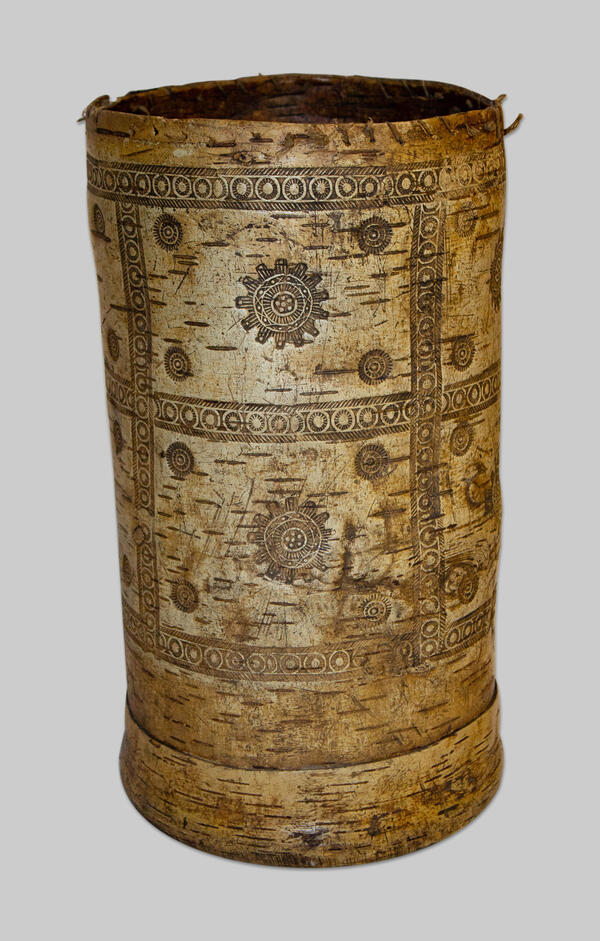Beresta is the thin top layer of birch bark of a delicate pinkish-cream color. Its ancient name ‘beresto’ has been known since the 15th–16th centuries. The words ‘beryosta’ and ‘berest’ appeared later, and are have been in active use ever since. Beresta handicraft has become an original type of folk art of its own. Birch bark drew the attention of craftsmen because during processing it retained its properties: softness, flexibility, and strength.
Since ancient times, boxes (buraks) have been made from birch bark: containers with a lid for storage of food and drinks. The container was made watertight. When leaving for work in the field, a peasant would take along a birch bark box with water or kvass (a traditional soft beverage made of brewed bread), and the liquid in this box remained cold on a summer day, no matter how hot. The box was made from a solid birch bark skOlotyen: a cylindrical chunk of birch bark pulled off a sawed tree.
Baskets were made using straight and diagonal weaving techniques. As opposed to boxes, Items weaved from birch bark typically did not bear additional decorations. The main aesthetic value was in the very shape of the product: the soft, velvety texture of birch bark. Spring birch bark has a somewhat cool yellow color, while autumn bark is of a warm, dark brown hue. Combining the bark of different shades provides an additional artistic effect.
The box featured in the collection of the Fyodor Reshetnikov Museum is decorated with a pattern of solar symbols. Solar symbols have been depicted on various utensils and religious objects for centuries. For the Eastern Slavs, solar symbols had primarily a protective value. Researcher of Slavic culture Boris Rybakov believes that these symbols were not used on their own, but illustrated a part of the universe, which the Eastern Slavs saw as follows: the earthly firmament with plants, animals, and people was covered with an arch of the sky, along which the sun moved. In this movement, the sun was depicted in several forms: Morning Sun, Midday Sun, and Evening Sun. The three of them together constituted the Triune Sun. Often, there was also a Midnight Sun, below the ground level: in the evening, it hid beneath one end of the earth and reappeared from under the other end in the morning.
Since ancient times, boxes (buraks) have been made from birch bark: containers with a lid for storage of food and drinks. The container was made watertight. When leaving for work in the field, a peasant would take along a birch bark box with water or kvass (a traditional soft beverage made of brewed bread), and the liquid in this box remained cold on a summer day, no matter how hot. The box was made from a solid birch bark skOlotyen: a cylindrical chunk of birch bark pulled off a sawed tree.
Baskets were made using straight and diagonal weaving techniques. As opposed to boxes, Items weaved from birch bark typically did not bear additional decorations. The main aesthetic value was in the very shape of the product: the soft, velvety texture of birch bark. Spring birch bark has a somewhat cool yellow color, while autumn bark is of a warm, dark brown hue. Combining the bark of different shades provides an additional artistic effect.
The box featured in the collection of the Fyodor Reshetnikov Museum is decorated with a pattern of solar symbols. Solar symbols have been depicted on various utensils and religious objects for centuries. For the Eastern Slavs, solar symbols had primarily a protective value. Researcher of Slavic culture Boris Rybakov believes that these symbols were not used on their own, but illustrated a part of the universe, which the Eastern Slavs saw as follows: the earthly firmament with plants, animals, and people was covered with an arch of the sky, along which the sun moved. In this movement, the sun was depicted in several forms: Morning Sun, Midday Sun, and Evening Sun. The three of them together constituted the Triune Sun. Often, there was also a Midnight Sun, below the ground level: in the evening, it hid beneath one end of the earth and reappeared from under the other end in the morning.



